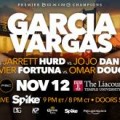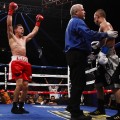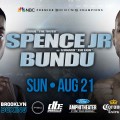Born in Wales in 1892 to the son of a coal
miner, Jimmy Wilde started boxing at the age of 16 in local fair grounds where
he would challenge local hard men in order to make ends meet. The on looking
crowd would gasp in amazement as the 5ft 2 inch Wilde took on all comers
regardless of their size and weight, often knocking out men twice his size with
his ferocious little fists.
According to official records, Wilde turned professional in December 1910,
where the young Welshman fought a no contest with Les Williams in Pontypridd,
Wales. This somewhat mediocre start was not, however, a sign of things to come
as ‘little Jimmy’ embarked on a 103 fight unbeaten run, seeing him capture the
British 7 stone championship with an eighth round KO of Billy Padden, a relative
novice from Glasgow. The little wizard looked unbeatable, making his opponents
look foolish by dodging and weaving onslaughts before popping out a jab with a
smile on his face. Rarely blocking or clinching due to his incredible size
disadvantage, Wilde’s style was unique in itself, often relying on his suburb
reflexes to make his opponent miss. When Wilde wanted the fight to be over, he
usually got his way as he stepped up the pressure before knocking his opponents
out.
Wilde’s impressive winning streak would come to an end, however, when he
challenged Tancy Lee for the vacant European Flyweight Title. Wilde, outweighed
officially by eleven pound on the day of the fight even though he was fully
clothed during the weigh-in, was finally stopped in the 17th round (of twenty)
after his corner called a halt to the action in what was a competitive affair. What
is interesting to note, however, is that a week before the bout, Jimmy Wilde was
diagnosed with influenza, and was physically sick moments before the fight. A
brief clip of the fight can be seen here:
http://www.youtube.com/watch?v=tKZdcBFE_7Q&feature=player_embedded
Wilde, seemingly aggravated by his first professional loss, then embarked on a brutal 16 fight
KO winning streak, winning the British Flyweight title against Joe Symonds
(58-9-5), stopping him in the twelfth round.
http://www.youtube.com/watch?v=igryTKKR2Nw&feature=player_embedded
Just three fights later, Wilde would win the IBU ‘World’ Flyweight title, defeating Johnny Rosner
in the 11th. (The IBU, while claiming to be a world organisation, was only
recognised in Europe.) This run also saw Wilde stop Sid Smith, a veteran of
almost 80 fights.
Feeling unbeatable, Wilde fought twice on the 13th May 1916, defeating both Joe
Magnus and Darkie Saunders in less than five rounds apiece at the Woolwich
Dockyard. On the 26th June of that year, a fully fit Wilde would avenge his
only loss to date, stopping Trancy Lee in the 11th.
Later that year, ‘The Mighty Atom’ officially became the first World Flyweight
Champion by stopping the colourfully named Young Zulu Kid in the 11th. The
fight, scheduled for 20, saw Wilde start quickly as the American had no answer
to the ‘Mighty Atom’s’ speed and power. The end came just after the half way
mark after Wilde landed a crushing left to the jaw of ‘the Kid’, causing the
American’s corner to throw in the towel. Just three months later, Wilde would
unify the World title with the British and European titles, stopping George
Clark in four. During this impressive winning streak, Wilde would fight Joe
Conn, a man Wilde claimed was Britain’s 9 stone champion in a catchweight fight.
The Welshman later said he weighed 6 stone 10 for this bout, but while Conn
refused to get on the scales. Newspaper observers later estimated Conn to
outweigh Wilde by almost 3 stone. Jimmy, nonetheless, stepped into the ring and
completely destroyed Conn, knocking him down a total of 13 times on route to a
12 round KO victory.
Jimmy Wilde continued winning until the 12th December 1918, when he was
defeated by the then Bantamweight World Champion Memphis Moore (54-6-13), an
opponent who was again rumoured to outweigh the fully clothed Wilde by 14 pound
on the night of the fight. Like his first defeat against Lee, Wilde would
avenge the loss in the rematch, defeating the American on points over twenty gruelling
rounds.
After the Moore rematch, Wilde embarked on a tour of the United States and Canada, winning ten
out of his eleven bouts, losing only to Jackie Sharkey, a fight in which he was
sure he won. Later on, Wilde joked that ‘the Americans stood no chance. I
knocked them all cold’, with victories of the great Frankie Mason (62-5-11),
Battling Al Murray (26-4), a rematch with Young Zulu Kid, and Patsy Wallace in
a bout which drew the largest crowd in Canadian boxing history.
Wilde’s career was to end with disappointing back to back defeats. In 1921, after almost 140 offical fights, the ‘Mighty Atom’ was knocked out by Pete Herman, whom again outweighed
Wilde by ten pound, in the 17th round. After a two year retirement, Wilde was
tempted into the ring once more against the Pilipino great Pancho Vella. The 31
year old Wilde started at a ferocious pace, tagging one of Asia’s finest ever
fighters with his trademark straight right and murderous hooks. The problem for
the Welshman, however, was Vella, although being wobbled on more than one
occasion, was taking the shot reasonably well, returning fire with his own
right hand. At the end of the second, the heavy punching Vella caught Wilde
flush after the bell had sounded, a blow which left the Mighty Atom concussed
for more than three weeks later. Legendary trainer Ray Arcel, who was at
ringside, felt the bout should have ended in disqualification. But Wilde
refused to appeal to the referee, and the fight continued. The groggy Welshmen
would go on to take a sustained beating from Vella who eventually knocked his
man out in the 7th round, sending Wilde into retirement for the
second and final time.
Jimmy Wilde’s record, however, doesn’t do him justice. While finishing with an official
record of 137-4-2 with 100 knockouts, Wilde would later claim to have fought a
total of 864 times, winning 675 by knockout. Wilde’s knockout ratio suggests he
was an all action slugger who threw bombs in an attempt to knock his opponent
out. This wasn’t the case however, as Wilde was a master of defence, often
making opponents look foolish by weaving onslaughts with his hands held low
before tagging his opponent seemingly at will. Boxing experts would refer to
him as ‘the ghost with a hammer in his hand’, so elusive was he. Wilde’s Boxrec
records also do not do him justice. Many of his opponents, particularly in his
early years, are shown to have very few fights. This again is misleading, as
the lower weights at the time were very rarely covered during this period of
British boxing.
In 1990, Wilde was elected into the Boxing Hall of Fame and, two years later,
was voted into the Welsh Sports Hall of Fame. A decade later, Ring Magazine
voted Wilde as the 3rd greatest puncher of all time, behind the great Joe Louis
and equally great Sam Langford.
Jimmy Wilde died as a result of injuries sustained in a mugging in 1969.
A fitting tribute to the Welsh wizzard can be seen here:
http://www.youtube.com/watch?v=nf2uTy9Os6c&feature=player_embedded








Speak Your Mind